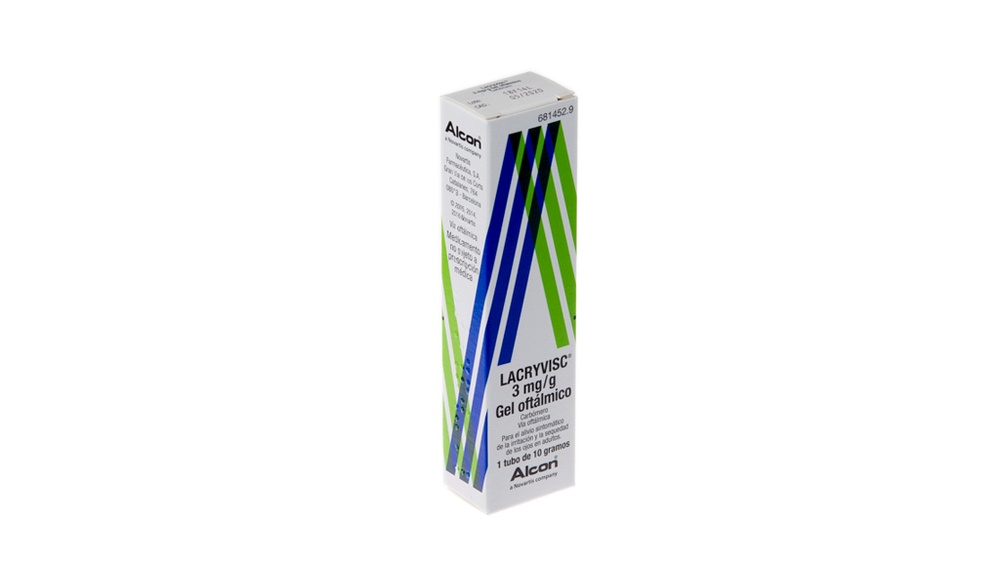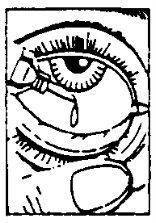

LACRYVISC 3 mg/g OPHTHALMIC GEL

Ask a doctor about a prescription for LACRYVISC 3 mg/g OPHTHALMIC GEL

How to use LACRYVISC 3 mg/g OPHTHALMIC GEL
Introduction
Package Leaflet: Information for the User
LACRYVISC 3mg/g Eye Gel
Carbomer
Read the entire package leaflet carefully before starting to use this medication,as it contains important information for you.
Follow the administration instructions for the medication contained in this package leaflet or as indicated by your doctor or pharmacist.
- Keep this package leaflet, as you may need to read it again.
- If you need advice or more information, consult your pharmacist.
- If you experience side effects, consult your doctor or pharmacist, even if they are side effects not listed in this package leaflet. See section 4.
- You should consult a doctor if it worsens or does not improve after 3 days.
Contents of the Package Leaflet
- What is Lacryvisc and what is it used for
- What you need to know before starting to use Lacryvisc
- How to use Lacryvisc
- Possible side effects
- Storage of Lacryvisc
- Package Contents and Additional Information
1. What is Lacryvisc and what is it used for
Lacryvisc is a liquid eye gel that contains the active ingredient carbomer, which is a highly viscous ocular lubricant capable of forming drops. After local application to the eye, it forms a protective lubricating film with high adhesion and long duration.
It is used for the symptomatic relief of eye irritation and dryness in adults.
You should consult a doctor if it worsens or does not improve after 3 days.
2. What you need to know before starting to use Lacryvisc
Do not use Lacryvisc
If you are allergic to carbomer or any of the other components of this medication (listed in section 6).
Warnings and Precautions
Consult your doctor or pharmacist before starting to use Lacryvisc.
Use this gel only in your eye(s).
The tip of the container should not come into contact with any surface, including the eye, as it may cause eye injury and the gel may become contaminated.
It is not recommended to wear contact lenses during treatment with this medication. See section "Lacryvisc contains benzalkonium chloride".
In case of iris inflammation or corneal diseases, you should consult your doctor, who will determine the possibility of using Lacryvisc as treatment.
If you experience eye pain, changes in vision, eye irritation, persistent redness, or if symptoms worsen or persist for more than 3 days, discontinue treatment and consult your doctor.
Children and Adolescents up to 18 years of age
In clinical practice, the safety and efficacy of Lacryvisc have been established in children and adolescents at the recommended dose in adults, but no data from clinical trials are available.
Using Lacryvisc with other medications
Tell your doctor or pharmacist if you are using, have recently used, or may need to use any other medication.
Pregnancy, Breastfeeding, and Fertility
If you are pregnant or breastfeeding, think you may be pregnant, or plan to become pregnant, consult your doctor or pharmacist before using this medication.
This medication can be used during pregnancy and breastfeeding.
Driving and Using Machines
You may notice that your vision becomes blurry for a while after applying the medication. If this happens, wait until the symptom disappears and your vision is clear before driving vehicles or using machines.
Lacryvisc contains benzalkonium chloride
This medication contains 0.001 mg of benzalkonium chloride per dose, equivalent to 0.05 mg/g.
Benzalkonium chloride can be absorbed by soft contact lenses, altering their color. Remove contact lenses before using this medication and wait 15 minutes before putting them back.
Benzalkonium chloride can cause eye irritation, especially if you have dry eye or other corneal diseases (the transparent layer on the front of the eye). Consult your doctor if you feel any strange sensation, itching, or pain in the eye after using this medication.
3. How to use Lacryvisc
Follow the administration instructions for the medication indicated by your doctor or pharmacist. If in doubt, consult your doctor or pharmacist again.
The recommended dose is one drop in the eye(s) 2 to 4 times a day, or whenever you experience eye discomfort associated with dry eye.
In certain cases and according to your doctor's instructions, Lacryvisc may be applied more frequently.
Children and Adolescents up to 18 years of age
In clinical practice, the safety and efficacy of Lacryvisc have been established in children and adolescents at the recommended dose in adults, but no data from clinical trials are available.
Elderly Patients
Lacryvisc can be used in elderly patients (over 65 years), and no dose adjustment is necessary.
Instructions for Use
To correctly administer Lacryvisc, follow the steps described below:
|
Since this is a sterile medication, it is recommended to follow the instructions below:
- Each patient will use their own container.
- The application of the gel should be done with maximum cleanliness, avoiding as much as possible contact between the tip of the tube and any surface (including the eyelid, fingers, etc.).
- After each application, close the container well.
- Lacryvisc should not be used after 4 weeks from the first opening of the tube and should be discarded even if it has not been fully consumed.
If you need to apply any other eye medication besides Lacryvisc, wait at least 5 minutes between applications. Lacryvisc should be administered last.
If you use more Lacryvisc than you should
Given its exclusive ocular administration, overdose is not expected.
In case of overdose or accidental ingestion, consult your doctor or call the Toxicology Information Service, phone 91 562 04 20, indicating the medication and the amount ingested.
If you forget to use Lacryvisc
Do not use a double dose to make up for forgotten doses.
If you have any other questions about the use of this medication, ask your doctor or pharmacist.
4. Possible Side Effects
Like all medications, this medication can cause side effects, although not everyone will experience them.
The following reactions may appear in your eyes:
Very Common(may affect more than 1 in 10 people):blurred vision.
Common(may affect up to 1 in 10 people):eye discomfort, eyelid crust, eye irritation.
Uncommon(may affect up to 1 in 100 people):eye swelling, eye pain, eye itching, eye redness, increased tear production.
Or, reactions in other parts of your body:
Uncommon(may affect up to 1 in 100 people):skin inflammation.
Other additional side effects have been observed during post-marketing experience with unknown frequency(cannot be estimated from available data): allergy (hypersensitivity).
Reporting Side Effects
If you experience any type of side effect, consult your doctor or pharmacist, even if it is a possible side effect not listed in this package leaflet. You can also report them directly through the Spanish Medication Surveillance System for Human Use: https://www.notificaRAM.es. By reporting side effects, you can contribute to providing more information on the safety of this medication.
5. Storage of Lacryvisc
Keep this medication out of sight and reach of children.
Do not store above 30°C.
Keep the container perfectly closed. The contents of the tube are sterile until first opening.
Do not use this medication after the expiration date shown on the tube and carton after EXP. The expiration date is the last day of the month indicated.
To avoid infections, discard the tube 4 weeks after first opening.
Write the opening date of the tube in the space provided on the carton for this purpose.
Medications should not be disposed of through wastewater or household waste. Deposit the containers and medications you no longer need at the SIGRE collection point in your pharmacy. If in doubt, ask your pharmacist how to dispose of containers and medications you no longer need. This will help protect the environment.
6. Package Contents and Additional Information
Lacryvisc Composition
- The active ingredient is carbomer. Each gram of gel contains 3 mg of carbomer.
- The other ingredients are benzalkonium chloride, sorbitol (E-420), sodium hydroxide, and purified water.
Appearance of the Product and Package Contents
Lacryvisc is a slightly opaque and slightly yellowish liquid eye gel.
The gel is presented in a carton containing a 10 g tube with a plastic dispenser tip and plastic cap.
Marketing Authorization Holder
Alcon Healthcare S.A.
World Trade Center Almeda Park
Plaça de la Pau s/n, Edificio 6, planta 3
08940 - Cornellà de Llobregat (Barcelona)
Spain
Manufacturer
S.A. Alcon-Couvreur N.V.
Rijksweg 14, B-2870 Puurs,
Belgium
or
Alcon Laboratories Belgium
Lichterveld 3
2870 Puurs-Sint-Amands
Belgium
Date of Last Revision of this Package Leaflet:February 2018
Detailed and updated information on this medication is available on the website of the Spanish Agency for Medicines and Health Products (AEMPS) http://www.aemps.gob.es/
- Country of registration
- Active substance
- Prescription requiredNo
- Manufacturer
- This information is for reference only and does not constitute medical advice. Always consult a licensed doctor before taking any medication. Oladoctor is not responsible for medical decisions based on this content.
- Alternatives to LACRYVISC 3 mg/g OPHTHALMIC GELDosage form: EYEDROP, 5.5 mg sodium chloride; 3 mg hypromellose/mlActive substance: artificial tears and other indifferent preparationsManufacturer: Alcon Healthcare S.A.Prescription not requiredDosage form: EYEDROP, 3.2 mg/mlActive substance: artificial tears and other indifferent preparationsManufacturer: Bausch & Lomb S.A.Prescription not requiredDosage form: EYE DROP, 3.2 mg/mlActive substance: artificial tears and other indifferent preparationsManufacturer: Bausch & Lomb S.A.Prescription not required
Alternatives to LACRYVISC 3 mg/g OPHTHALMIC GEL in other countries
The best alternatives with the same active ingredient and therapeutic effect.
Alternative to LACRYVISC 3 mg/g OPHTHALMIC GEL in Польша
Alternative to LACRYVISC 3 mg/g OPHTHALMIC GEL in Украина
Online doctors for LACRYVISC 3 mg/g OPHTHALMIC GEL
Discuss dosage, side effects, interactions, contraindications, and prescription renewal for LACRYVISC 3 mg/g OPHTHALMIC GEL – subject to medical assessment and local rules.















